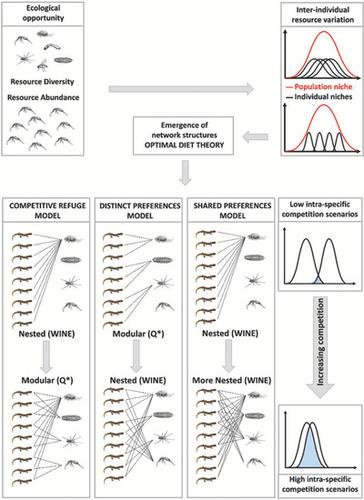当前位置:
X-MOL 学术
›
Integr. Zool.
›
论文详情
Our official English website, www.x-mol.net, welcomes your feedback! (Note: you will need to create a separate account there.)
Weighted individual-resource networks in prey–predator systems: the role of prey availability on the emergence of modular structures
Integrative Zoology ( IF 3.3 ) Pub Date : 2021-01-07 , DOI: 10.1111/1749-4877.12520 Andrea Costa 1 , Antonio Romano 2 , Giacomo Rosa 1 , Sebastiano Salvidio 1
Integrative Zoology ( IF 3.3 ) Pub Date : 2021-01-07 , DOI: 10.1111/1749-4877.12520 Andrea Costa 1 , Antonio Romano 2 , Giacomo Rosa 1 , Sebastiano Salvidio 1
Affiliation

|
Ecological networks, usually depicting interactions among species, have been recently down-scaled to the individual level, permitting description of patterns of inter-individual resource variation that are usually hindered at the species level. Optimal diet theory (ODT) models, applied to prey–predator systems, predict different patterns of nestedness and modularity in the network, depending on the available resources and intra-specific competition. The effect of resource availability on the emergence of networks structures, and ODT framework, has not yet fully been clarified. Here, we analyzed the structural patterns of individual-resource networks in 3 species of Mediterranean salamanders, in relation to changes in prey availability. We used weighted individual-resource network metrics to interpret the observed patterns, according to 3 ODT models. We found significant nestedness recurring in our study system, indicating that both selective and opportunistic individuals occur in the same population. Prey diversity, rather than abundance, was apparently related to inter-individual resource variation and promoted the emergence of significant modularity within all networks. The observed patterns of nestedness and modularity, together with the variation in resource diversity and intra-specific competition, are in agreement with the distinct preferences model of ODT. These findings suggest that in the focal prey–predator systems, individuals were able to perceive changes in prey diversity and to exploit in different ways the variations in composition of available resources, shifting their diet assembly rules accordingly. Our findings also confirm that the use of weighted individual-resource networks, in prey–predator systems, allows to disclose dynamics that are masked at the species or population level.
中文翻译:

猎物-捕食者系统中的加权个体资源网络:猎物可用性对模块化结构出现的作用
生态网络,通常描述物种之间的相互作用,最近被缩小到个体层面,允许描述通常在物种层面受到阻碍的个体间资源变化模式。应用于猎物-捕食者系统的最佳饮食理论 (ODT) 模型预测网络中不同的嵌套和模块化模式,具体取决于可用资源和种内竞争。资源可用性对网络结构和 ODT 框架出现的影响尚未完全阐明。在这里,我们分析了 3 种地中海蝾螈个体资源网络的结构模式,与猎物可用性的变化有关。我们使用加权的个人资源网络指标来解释观察到的模式,根据 3 个 ODT 模型。我们发现在我们的研究系统中重复出现了显着的嵌套性,这表明选择性和机会主义的个体都出现在同一群体中。猎物多样性,而不是丰度,显然与个体间资源变异有关,并促进了所有网络中显着模块化的出现。观察到的嵌套和模块化模式,以及资源多样性和种内竞争的变化,与 ODT 的不同偏好模型一致。这些发现表明,在焦点猎物-捕食者系统中,个体能够感知猎物多样性的变化,并以不同的方式利用可用资源组成的变化,从而相应地改变他们的饮食组装规则。
更新日期:2021-01-07
中文翻译:

猎物-捕食者系统中的加权个体资源网络:猎物可用性对模块化结构出现的作用
生态网络,通常描述物种之间的相互作用,最近被缩小到个体层面,允许描述通常在物种层面受到阻碍的个体间资源变化模式。应用于猎物-捕食者系统的最佳饮食理论 (ODT) 模型预测网络中不同的嵌套和模块化模式,具体取决于可用资源和种内竞争。资源可用性对网络结构和 ODT 框架出现的影响尚未完全阐明。在这里,我们分析了 3 种地中海蝾螈个体资源网络的结构模式,与猎物可用性的变化有关。我们使用加权的个人资源网络指标来解释观察到的模式,根据 3 个 ODT 模型。我们发现在我们的研究系统中重复出现了显着的嵌套性,这表明选择性和机会主义的个体都出现在同一群体中。猎物多样性,而不是丰度,显然与个体间资源变异有关,并促进了所有网络中显着模块化的出现。观察到的嵌套和模块化模式,以及资源多样性和种内竞争的变化,与 ODT 的不同偏好模型一致。这些发现表明,在焦点猎物-捕食者系统中,个体能够感知猎物多样性的变化,并以不同的方式利用可用资源组成的变化,从而相应地改变他们的饮食组装规则。



























 京公网安备 11010802027423号
京公网安备 11010802027423号